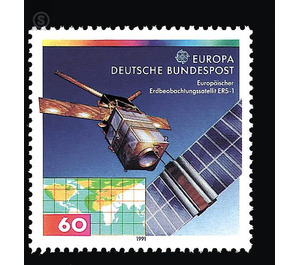Europe - Germany / Federal Republic of Germany 1991 - 60 Pfennig
Theme: Astronomy & Space
| Country | Germany / Federal Republic of Germany |
| Issue Date | 1991 |
| Face Value | 60.00 |
| Color | blue |
| Perforation | K 13 3/4 |
| Printing Type | Seven-color offset printing |
| Stamp Type | Postage stamp |
| Item Type | Stamp |
| Chronological Issue Number | 1399 |
| Chronological Chapter | GER-BRD |
| SID | 788041 |
| In 58 Wishlists | |
Lakes and oceans cover around two thirds of the earth's surface at around 360 million km2. Through heat exchange and circulation processes, they are an essential force that has a global influence on the weather and the climate. Enormous economic resources are believed in their depth. The large ice fields, the z. For example, covering the Arctic and Antarctic are of major importance for global weather as well as local weather changes. The scientific exploration of these causal relationships, their causes and interactions are still in their infancy. The European Earth Observation Satellite ERS-1, a large joint project of member countries of the European Space Agency ESA, will provide a wealth of data for science. ERS-1 will observe the oceans, locate ocean currents, map the tropical rainforest and survey the Antarctic continent. He is able to measure the height of the ocean waves at half a meter from space - even at night or in dense clouds. ERS-1 will identify icebergs and even individual ice floes, as well as analyze the ice of glaciers in the Antarctic for age, texture and dynamics. This will be the first systematic and empirically collected information that can help answer the question of whether and to what extent the greenhouse effect causes global warming and melting of the polar ice. These data will significantly improve the climate models currently used in science. ERS-1 can also look deep and measure ocean currents. His data will be able to serve sea shipping and sea weather forecasting; but they also allow more accurate scientific interpretations of climate events. (Text: The Federal Minister for Research and Technology, Bonn)


